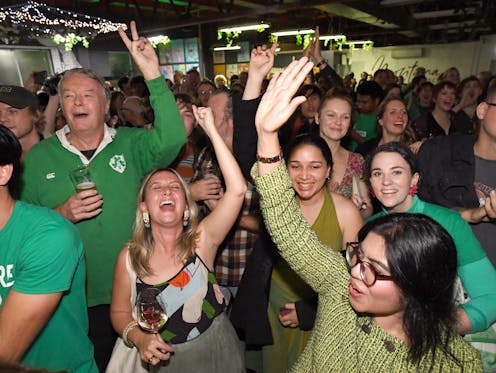Queensland bucks the national trend (again) and this spells trouble for both the Liberals and ALP
- Written by Paul Williams, Associate Professor, Griffith University, Griffith University

There’s an ancient observance in Chinese history that an earthquake is an ominous omen of coming political change. When the ground shakes it’s said the heavens are withdrawing an emperor’s mandate and encouraging people to rise up against a dying dynasty.
A few days ago, a sizeable quake shook Macquarie Island [1] 1,500 km off Tasmania. While that island is hardly Canberra, Australia’s own electoral gods – the good burghers of the capital cities’ suburbs – nonetheless forced a tectonic shift in Australian politics on Saturday.
The aftershocks are likely to reverberate around the nation’s party system for years to come. Labor leader Anthony Albanese may still form majority government but, even if not, a few trends remain clear.
Political realignments
The first is the devastation of the Liberal Party. There was a 6% swing[2] against the Coalition but this is largely a Liberal, not Coalition or National party problem. That’s roughly the size of the quake that demolished Paul Keating’s Labor government in 1996 and delivered an electoral “realignment” where “aspirational” working class Australians first moved to the Liberal-National Coalition.
Saturday’s movement from the Liberals (and, to a lesser degree, Labor) to the teals and Greens across the suburbs suggests another political realignment has occurred.
A second trend is the electorate’s rejection of outgoing Prime Minister Scott Morrison’s personal “bulldozer” style – a leadership type he foolishly acknowledged[3] in the final week of the campaign.
But this is a Liberal problem as much as Morrison’s: when a party puts all its electoral eggs in the leadership basket (and encourages its leader to behave presidentially via “captain’s pick” pre-selections[4]), the party has nothing left to sell when those leadership eggs are broken.
Existential crises
Third, and even more critically, Saturday was a rejection of a Liberal party that had become so conservative in its social, climate and wage policy that voters in the inner and middle suburbs could no longer stomach it. Only in the outer suburbs, provinces and regions (especially in Queensland and Tasmania, and particularly among older, male and blue-and fluoro-collar voters) did the conservative vote hold up.
This leads to a fourth theme – an existential crisis as to who the Liberals are and whom they represent. With moderate and progressive Liberals, most commonly in safe and leafy Liberal seats, wiped out on Saturday in a red wave in Perth, a green wave in Brisbane[5] and a teal wave in Sydney and Melbourne, the next Liberal party room is likely to be the most conservative since the Menzies’ era.
There is a great irony here. At a moment when (especially younger, educated urban and suburban) Australians have jumped to the centre-left and demanded action on climate change, cost-of-living and government integrity, a now-battered Liberal party – likely to be led by the very conservative Queenslander Peter Dutton – may be more resistant to the progressive zeitgeist than ever.
If the Liberals cannot reconcile its deepening conservatism – based in Queensland[6] where the Liberal National Party lost only two seats in Brisbane[7] while maintaining all regional representation from Caboolture to Cape York – with an increasingly progressive electorate across Australia’s inner and middle suburbs, its longer-term prospects come into question.
Read more: State of the states: six politics experts take us around Australia in the final week of the campaign[8]
Moreover, given the Liberals have seen support spin off in three directions – to Labor, the teals and to the populist right of Pauline Hanson and Clive Palmer (especially in Queensland) – the party that has governed federally for 51 of the past 73 years might be out of office for more than a decade.
While the Senate count is far from complete, it already appears Hanson is struggling to be re-elected. It’s also evident that the Liberal Democrats under former premier Campbell Newman, as well as the United Australia Party, have spectacularly fizzled despite Palmer spending millions.
Labor faces its own threats
But Labor faces its own existential threat in suffering a primary vote locked in the low 30s across Australia, and in the high 20s in Queensland. With fewer than one in three Australians now opting for Labor – and just over one in four Queenslanders – hundreds of thousands of capital city dwellers now see the Greens and teals as the only forces able to deliver on climate, integrity and equality.
This is certainly the case in Brisbane where the Greens – building on recent Brisbane City Council and state seat successes – have picked up the western Brisbane electorate of Ryan[9], and are set to win Griffith and Brisbane, too. If so, the departures of up-and-coming Labor MP Terri Butler and Liberal MP Trevor Evans will be a mammoth loss to the parliament.
Labor’s identity and mission are also in question. Albanese, while only the fourth Labor opposition leader to take office since the end of World War II, is the first to come to the top job without a comprehensive platform of policy reform.
Last, this election reveals that Australian voters, wracked with fears over the cost-of-living, unrepresentative leadership and weak climate policy, were indeed in the mood for change. But that change, toward the Greens and independents, took a turn few expected, and did not occur at all in regional Queensland.
Once again, the 2022 federal election reminds us that Queensland is indeed different.
References
- ^ quake shook Macquarie Island (www.news.com.au)
- ^ 6% swing (www.abc.net.au)
- ^ foolishly acknowledged (theconversation.com)
- ^ “captain’s pick” pre-selections (theconversation.com)
- ^ green wave in Brisbane (www.smh.com.au)
- ^ based in Queensland (tallyroom.aec.gov.au)
- ^ only two seats in Brisbane (www.abc.net.au)
- ^ State of the states: six politics experts take us around Australia in the final week of the campaign (theconversation.com)
- ^ western Brisbane electorate of Ryan (tallyroom.aec.gov.au)













